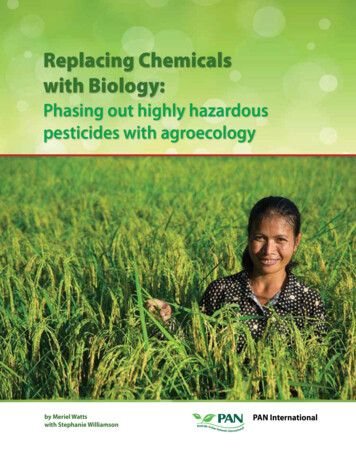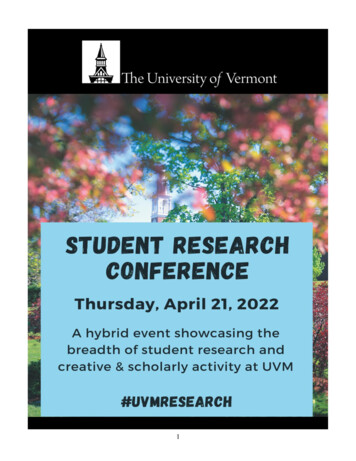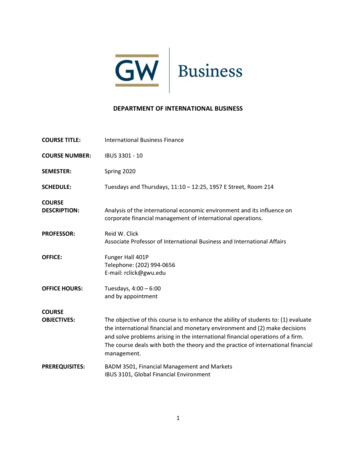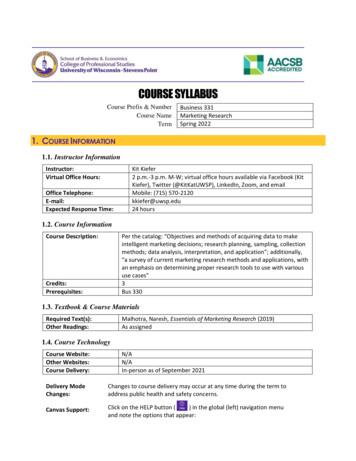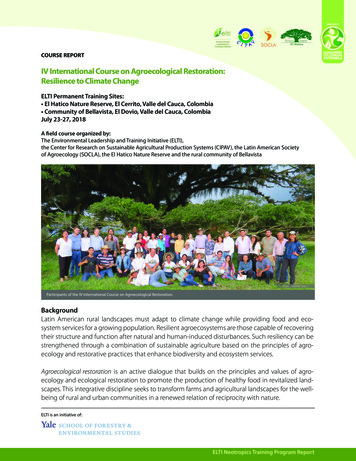
Transcription
COURSE REPORTIV International Course on Agroecological Restoration:Resilience to Climate ChangeELTI Permanent Training Sites: El Hatico Nature Reserve, El Cerrito, Valle del Cauca, Colombia Community of Bellavista, El Dovio, Valle del Cauca, ColombiaJuly 23-27, 2018A field course organized by:The Environmental Leadership and Training Initiative (ELTI),the Center for Research on Sustainable Agricultural Production Systems (CIPAV), the Latin American Societyof Agroecology (SOCLA), the El Hatico Nature Reserve and the rural community of BellavistaPhoto: Zoraida CalleParticipants of the IV International Course on Agroecological Restoration.BackgroundLatin American rural landscapes must adapt to climate change while providing food and ecosystem services for a growing population. Resilient agroecosystems are those capable of recoveringtheir structure and function after natural and human-induced disturbances. Such resiliency can bestrengthened through a combination of sustainable agriculture based on the principles of agroecology and restorative practices that enhance biodiversity and ecosystem services.Agroecological restoration is an active dialogue that builds on the principles and values of agroecology and ecological restoration to promote the production of healthy food in revitalized landscapes. This integrative discipline seeks to transform farms and agricultural landscapes for the wellbeing of rural and urban communities in a renewed relation of reciprocity with nature.ELTI is an initiative of:ELTI Neotropics Training Program Report
This course presented the principles of agroecology and ecological restoration and explored thecomplementarities and synergies between both disciplines. Course activities took place at two sitesthat showcase innovative farming systems, forest conservation and restoration initiatives in the Valledel Cauca, Colombia: El Hatico Nature Reserve (El Cerrito municipality) and the rural community ofBellavista (El Dovio municipality).The course combined lectures on agroecology, ecological restoration and sustainable livestock production with field visits and a group exercise in which participants were asked to apply the concepts learned throughout the course to solve a specific problem. Most lectures and field exercisestook place at El Hatico Nature Reserve (ELTI’s main permanent training site in Colombia), an estatethat has been managed by nine generations of a single family and is an international reference forsustainable agriculture. A one-day field trip to the community of Bellavista in the western Andes,illustrated applications of the principles of agroecology and forest restoration in small properties.ELTI alumni from this community coordinated and facilitated all field activities, and the preparationof an agrobiodiversity dinner with local organic ingredients.ObjectivesThe main objective of this course was to foster a conversation between two disciplines that envision thetransformation of farms and landscapes for the wellbeing of rural communities in a renewed relationwith nature: agroecology and ecological restoration. The course was based on the following themes:Principles and applications of agroecology and ecological restoration Transformation of conventional agricultureFunctional biodiversity in agroecosystemsSustainable cattle ranchingRestoring agricultural landscapesStrengthening resilience to climate changeExamples and case studies of Agroecological Restoration El Hatico Nature Reserve: silvopastoral systems, organic sugar cane and forest restorationCommunity of Bellavista: participatory research for sustainable farming and restoration
Photo: Enrique MurgueitioGuided tour of El Hatico, with music.Field-course formatThis course combined lectures with a guided tour of El Hatico, short presentations of participants,group projects, a field trip, practical exercises and a concert of Latin American music. The participation of composer Adolfo Cardozo as a trainer provided an opportunity to enjoy folk music from theLlanos of Venezuela and Colombia, and to discuss the role of traditional music in rural sustainabilityand restoration. Throughout the course all participants were involved in group projects designed toenhance sustainable farming and restoration practices at El Hatico.Food was an essential part of the curriculum. Each meal served throughout the course was designedto celebrate ethical food production in rural communities. All food was locally and sustainably produced, and in some cases, organic. ELTI alumni from previous Agroecology & Restoration courses(and one trainer) provided fruits, vegetables, wheat, cheese, yogurt, beans and fish from their farms.Meat came from El Hatico’s amazing silvopastoral systems. Other products were purchased at thelocal farmers’ market.Day 1The first day began with a presentation of the participants and course agenda, followed by a talk inwhich Juan José and Carlos Hernando Molina (8th and 9th generation owners of El Hatico), explainedthis farm’s approach to restoration and sustainable food production. After that, Miguel Altieri introduced the principles of agroecology, and ELTI’s Colombia coordinator, Zoraida Calle, gave a presentation about ecological restoration in agricultural landscapes.During the afternoon, the group was divided into five sub-groups for a guided tour of the silvopastoral systems, living fences, grazing sheep, organic sugar cane, the restored biological corridor
and the new forest trail of El Hatico. Participants wereencouraged to identify and rate the principles of agroecology that were exemplified at each station. All groupsobserved the complex silvopastoral systems that form awildlife friendly agricultural matrix and analyzed the rolethat functional biodiversity and animal welfare play inthe enhanced milk production of these systems. Theyalso observed the results of a forest restoration initiativethat began two decades ago.After the field visit, three participants made presentations of their farms and conservation projects, highlighting their own experiences of agroecology and restoration.Photo: Enrique Murguetio“Biological control in silvopastoral systems” work group.Day 2The morning session began with another series of presentations made by course participants, followed by alecture on agroecology and functional biodiversity byClara Nicholls, and an interesting presentation on sustainable livestock production, in which Enrique Murgueitio explained how agroecology and restoration relateto animal husbandry. After that, participants worked forthree hours on group projects that focused on the following issues: Natural biological control in silvopastoralsystems;Secondary forest restoration;Designing and planting a vegetable garden;Planning the use of livestock manure and charcoal in farming and restoration, andIntegrating native stingless bees and honey beesinto silvopastoral systems (perm-apiculture).Each group included one course instructor, a memberof the Molina family (owners of El Hatico) and fivecourse participants.Photo:Zoraida Calle“Biological control in silvopastoral systems” work group.After the group work session, composer and researcher Adolfo Cardozo illustrated the role of traditional music in agroecological restoration in a lectureinterspersed with folk songs. The last talks of the day
Photo: Enrique MurgueitioField visit to the community of Bellavista (municipality of El Dovio).were presented by participants who introduced new challenges and contexts for ecologicalrestoration and agroecological food production.Day 3The day began with a short talk in which Zoraida Calle presented the results of participatory research for ecological restoration, done in collaboration between CIPAV and young co-researchersfrom the community of Bellavista. This was followed by lectures on the adoption of agroecologicalpractices in conventional agriculture, by Miguel Altieri, and resilience to climate change, by ClaraNicholls. After this, the subgroups worked on their field projects.After lunch, the group travelled to the municipality of El Dovio, with a strategic stop at the point wherethe road crosses the Western Andes. Here, Enrique Murgueitio explained the climate and geography ofthe Valle del Cauca region and its implications for the distribution of life zones and biodiversity. Enriquealso summarized the land use history of the region and its social and economic drivers.The group stayed at Las Hojas hotel in El Dovio, where ELTI alumna Adriana Giraldo presented the25-year process of participatory research for food sovereignty and restoration in the community ofBellavista, and explained how research contributed to forming community groups and empoweringfarmers. A very nice traditional dinner was prepared by a group of women from El Dovio using localingredients and undervalued genetic resources. This celebration of agrobiodiversity included a variety of ingredients that were new for most course participants. The day ended with a performanceof folk music.
Day 4The day began early with a jeep tour to Bellavista.After breakfast, the group was divided into subgroups, which rotated through four small farms.On each one-hour farm visit, participants observedpolycultures, agroforestry systems and restoredriparian forests, and were involved in practical activities such as planting wax palms (Ceroxylon alpinum), arracacha (Arracacia xanthorrhiza, an Andean root vegetable), bore (Alocasia macrorrhiza, afodder species, useful in riparian restoration), andpineapple in contour lines for erosion control.Photo: Zoraida CalleKaren Ayala plants a wax palm in an agroforestry system.After lunch, the farmers of Bellavista shared theirexperience in forming the CAMPAB communitygroup and managing their own revolving fund forsmall projects. The field day at El Dovio ended witha presentation of the children and youth that worktogether in the Heirs of Bellavista group. Each groupmember explained the farming, conservation andrestoration activities that take place at their family’sproperty. Participants were deeply moved by thepride with which the young Heirs presented theirfarms, and by the story of a young lady who runs afarm by herself after her family moved to a nearbytown. Afterwards, the group returned to El Dovioand El Hatico.Day 5The last day began with the institutional presentation of ELTI and its Leadership Program. Course participants dedicated the next hours to finish theirgroup projects and present them at a plenary session.Photo: Zoraida CallePlanting pineapple in contour lines for erosion control atAlonso Carmona’s farm.This was followed by a group discussion on the synergies between agroecology and restoration, basedon the observations made at El Hatico and Bellavista. Finally, the group visited El Hatico’s emblematicrain tree Albizia saman with Carlos Hernán Molina(7th generation owner), who has shared nine decadeswith this beautiful tree. The course closed with a LatinAmerican music concert and dinner.
Photo: Enrique MurgueitioParticipants of the IV International Course on Agroecological Restoration.ParticipantsThis field course was announced in ELTI’s, CIPAV’s and SOCLA’s web pages. The 25 individuals selected to attend it represented farmers, nature reserve owners, NGOs, private companies and academia from Colombia, Panama, Venezuela, Chile, Argentina, Brazil, Cuba and Canada. Fifteen participants had attended the II Silvopastoral Heirs Workshop that took place during the previous week. Fiveparticipants were professionals and pilot farm owners involved in the Mainstreaming Biodiversity inSustainable Cattle Ranching Project in Colombia (Proyecto Ganadería Colombiana Sostenible)1.Instructors Zoraida Calle, ELTI (Colombia Program) and CIPAV, Colombia Enrique Murgueitio, CIPAV, Colombia Miguel Altieri, University of California (Berkeley) Clara Nicholls, University of California (Berkeley) René Zazueta, University of California (Berkeley) Adolfo Cardozo, CENDI (Venezuela) and CIPAV1. The Mainstreaming Biodiversity in Sustainable Cattle Ranching Project (GCS Ganadería Colombiana Sostenible) promotes the adoption of environmentally friendlysilvopastoral systems (SSP) that enhance farm productivity, natural resource management and the delivery of environmental services. Project partners are the GEF,Department of Business, Energy & Industrial Strategy (UK), The World Bank, Fedegan, The Nature Conservancy, CIPAV and Fondo Acción. This initiative seeks to scale upSSP and integrate them with ecological conservation and restoration in five Colombian landscapes: Cesar River valley and lower Magdalena in the dry Caribbean region;Andean Oak Corridor in Boyacá and Santander; the Coffee Ecoregion and the eastern Andes foothills in Meta department. Pilot farm owners work actively in farmer tofarmer training and therefore play a key role in scaling-up the adoption of SSP and ecological restoration practices, and in promoting cultural change towards sustainablelivestock production.
Photo: Enrique Murgueitio“Carlos Hernán Molina, 7th generation owner of El Hatico Nature Reserve, shares his poem dedicated to the rain tree”. Carlos Hernán Molina, El Hatico Nature Reserve, ColombiaCarlos Hernando Molina, El Hatico Nature Reserve, ColombiaEnrique José Molina, El Hatico Nature Reserve, ColombiaJuan José Molina, El Hatico Nature Reserve, ColombiaJulián Andrés Giraldo (ELTI alumnus), CIPAV, ColombiaAdriana Giraldo (ELTI alumna), CIPAV, ColombiaNelly Victoria Giraldo (ELTI alumna), CIPAV, ColombiaRamiro Giraldo, Gilberto Giraldo and Alonso Carmona, Community of Bellavista (El Dovio,Colombia)Outcomes and Follow-up:Course participants showed great motivation during all lectures, field visits, group discussions andexercises. The 15 adults and teenagers who had previously attended the II Silvopastoral Heirs Workshop made excellent contributions to the field course. The diverse perspectives and experiencesfrom nature reserve owners, farmers and professionals of tropical, subtropical and temperate countries enriched the dialogue between agroecology and restoration.This event was possible thanks to Arcadia Fund, whose Environmental Conservation grants supportprogrammes that protect and enhance biodiversity, and provide field training and academic research.
El Hatico Nature Reserve, El Cerrito, Valle del Cauca, Colombia Community of Bellavista, El Dovio, Valle del Cauca, Colombia July 23-27, 2018 . lighting their own experiences of agroecology and res-toration. Da
